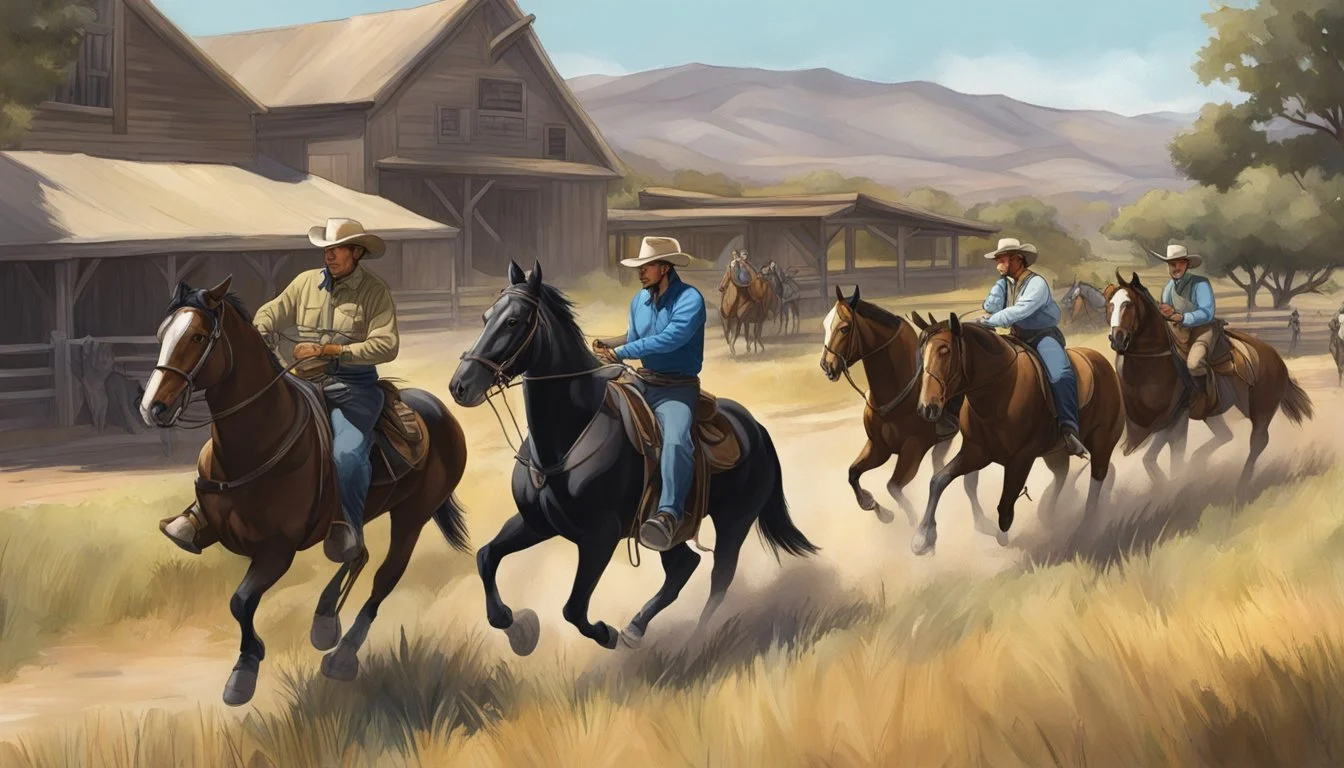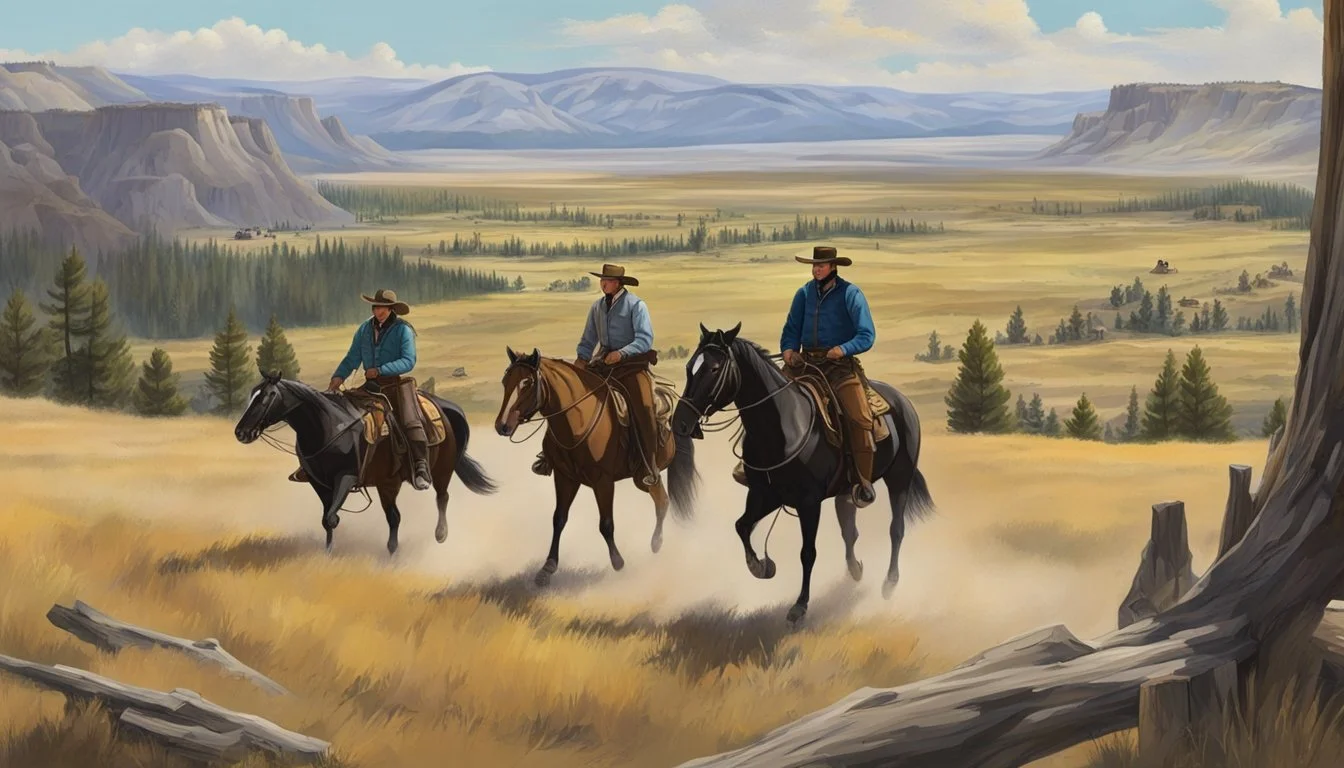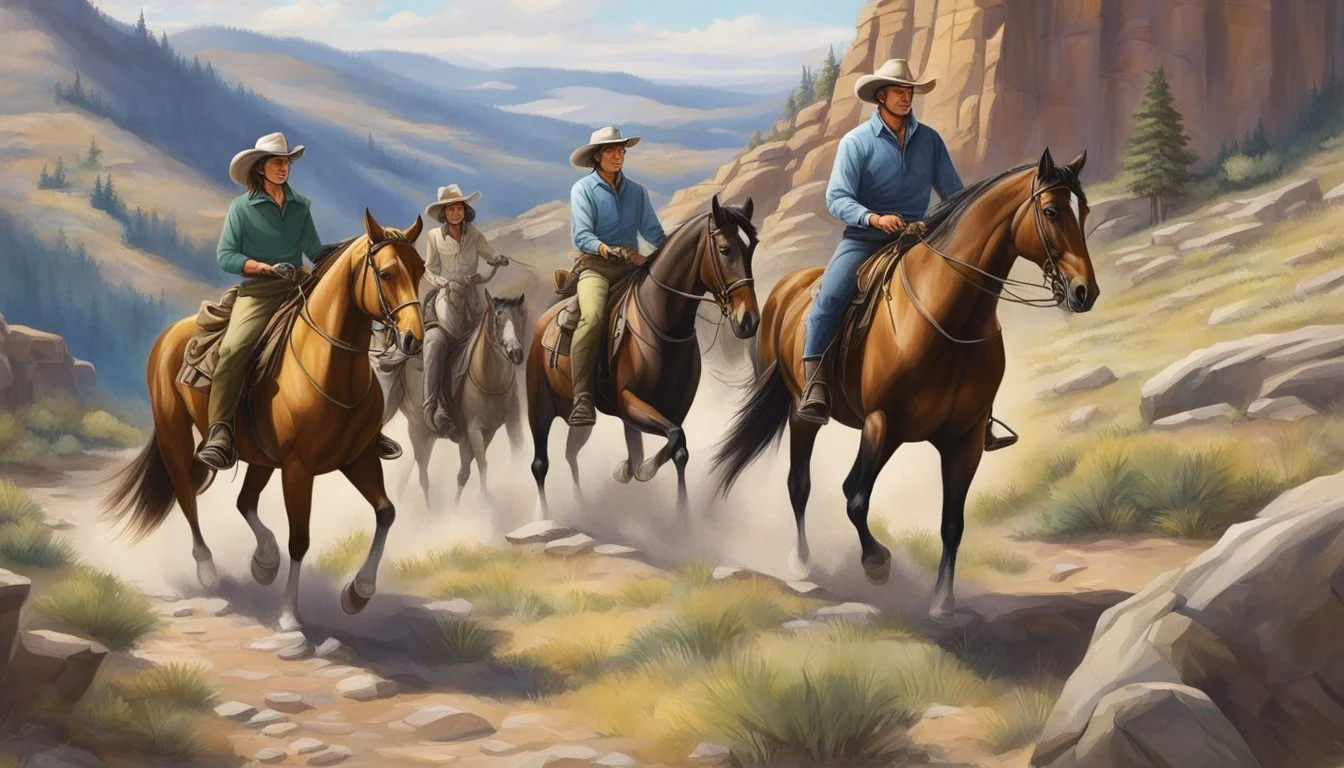Workers Revolt at Dutton Ranch Exposing Dark Secrets Behind Yellowstone's Fame
Yellowstone, the hit TV series created by Taylor Sheridan, offers a gripping portrayal of ranch life in Montana's rugged landscape. At the center of the show's drama lies the Dutton Ranch, a sprawling cattle operation run by the formidable Dutton family. The series delves into the complex dynamics of ranch management, including the often-overlooked topic of workers' rights.
The Dutton Ranch's approach to labor practices reflects broader issues faced by workers in the American West. The show's depiction of ranch hands' working conditions and their relationship with the Dutton family leadership provides a window into the unique challenges of agricultural employment. From long hours to dangerous tasks, the life of a ranch hand is far from easy.
The series explores the tension between traditional ranch hierarchy and modern labor expectations. As the Duttons fight to preserve their way of life, they must navigate changing societal norms and legal requirements regarding worker treatment. This struggle mirrors real-world debates about fair labor practices in rural America, making Yellowstone a relevant commentary on contemporary issues in the agricultural sector.
Historical Context of the Dutton Ranch
The Dutton Ranch's history spans generations, intertwining with key moments in American Western expansion and development. Its story reflects the challenges and transformations of ranching life in Montana from the late 19th century through the mid-20th century.
The Founding of Dutton Ranch
James Dutton established the ranch in 1883, during the height of Western expansion. He claimed a vast tract of Montana land, laying the foundation for what would become a sprawling cattle empire. The 1880s marked a period of rapid settlement in the American West, with ranchers and homesteaders flocking to the region.
Dutton's timing coincided with the completion of the Northern Pacific Railway, which facilitated the transportation of cattle to eastern markets. This strategic location gave the ranch a significant advantage in the burgeoning cattle industry.
Significance of the 1883, 1923, and 1944 Eras
1883: The ranch's founding year saw the end of the open range era. Barbed wire fences began to reshape the landscape, altering traditional cattle driving practices.
1923: This year marked the beginning of the end for many small ranches. The post-World War I agricultural depression hit Montana hard, forcing many families off their land.
1944: As World War II neared its end, the ranch faced new challenges. Modernization and mechanization began to transform ranching practices, requiring adaptation to survive.
The Exploration of Ranch Life Over Generations
The Dutton Ranch's story mirrors the evolution of the American West. Each generation faced unique challenges:
1st Generation: Establishing the ranch amidst conflicts with Native Americans and other settlers.
2nd Generation: Surviving the Great Depression and adapting to changing markets.
3rd Generation: Balancing tradition with modernization in the post-war era.
These generations maintained ranching traditions while navigating shifts in the cattle industry, land use policies, and economic pressures. Their experiences reflect the broader narrative of Montana's ranching heritage and its place in American history.
Analysis of the Duttons' Leadership and Governance
The Dutton family's leadership style blends traditional ranching values with shrewd business acumen. Their governance of the Yellowstone Ranch reflects complex family dynamics and a fierce determination to maintain control.
John Dutton's Role as a Patriarch
John Dutton stands as the undisputed leader of the Yellowstone Ranch. His authoritative presence shapes every aspect of the family's operations. John's leadership style is marked by unwavering resolve and a willingness to make tough decisions.
He often employs harsh methods to protect the ranch's interests. This includes leveraging political connections and engaging in morally ambiguous tactics. John's approach to governance emphasizes loyalty and obedience above all else.
His children occupy key positions within the ranch hierarchy. This structure reinforces John's control while grooming the next generation of leadership.
Character Development Through Leadership
The Dutton children's leadership roles contribute significantly to their character arcs. Beth Dutton's cutthroat business strategies reflect her father's influence. Her aggressive tactics in corporate boardrooms mirror the ranch's defensive posture.
Jamie Dutton's legal and political maneuvers showcase a different facet of leadership. His efforts to navigate complex legal landscapes often clash with the family's more direct methods. This tension drives much of Jamie's character development.
Kayce Dutton's leadership style evolves as he balances his roles as a rancher, family man, and former Navy SEAL. His approach often incorporates a unique blend of military discipline and ranching tradition.
Trust and Loyalty Within the Dutton Family
The Dutton family's governance model hinges on absolute loyalty. Trust within the family is both a strength and a source of conflict. John Dutton demands unwavering allegiance from his children and employees alike.
This emphasis on loyalty creates a tight-knit workforce on the ranch. However, it also leads to intense internal struggles when family members' interests diverge. The ranch's hierarchy extends beyond blood relations, with trusted employees like Rip Wheeler occupying pivotal roles.
Family loyalty often trumps legal and ethical considerations in the Duttons' decision-making process. This prioritization of family interests over broader concerns frequently puts them at odds with external forces.
Portrayal of Workers' Rights and Ranch Hands' Lives
The Yellowstone series offers a nuanced depiction of life for ranch hands on the Dutton Ranch. It explores the complex dynamics between workers, their duties, and their relationships with the Dutton family.
Daily Realities for Yellowstone Dutton Ranch Workers
Ranch hands on the Dutton Ranch face demanding physical labor and long hours. Their days begin before sunrise, tending to livestock and maintaining the vast property. Tasks include mending fences, branding cattle, and managing grazing rotations.
The work is often dangerous, with risks from unpredictable animals and harsh weather conditions. Ranch hands must be skilled horsemen and possess a deep understanding of animal behavior.
Despite the challenges, many find fulfillment in the cowboy lifestyle. The connection to the land and the sense of purpose in preserving a traditional way of life are strong motivators.
Ranch Hands and the Bunkhouse Culture
The bunkhouse serves as the heart of ranch hand community. It's a space where workers live, socialize, and form tight-knit bonds. This living arrangement fosters a unique culture of camaraderie and shared experiences.
Bunkhouse life is characterized by:
Communal meals
Story-sharing
Informal mentoring between veteran and younger hands
The close quarters can lead to tensions, but also create a family-like atmosphere. Veteran hands often take on leadership roles, guiding newcomers in ranch operations and cowboy ethics.
The Balance Between Work and Personal Loyalty
Loyalty is a central theme in the lives of Dutton Ranch workers. The series explores the complex relationship between professional obligations and personal allegiances.
Ranch hands often find themselves torn between:
Following orders from the Duttons
Their own moral compasses
Loyalty to fellow workers
The show portrays the emotional toll of these conflicting loyalties. Workers sometimes face difficult choices that test their commitment to the ranch and their personal values.
The Dutton family's leadership style blurs the line between employer and family, creating a unique dynamic. This approach can inspire deep dedication but also raise questions about workers' rights and autonomy.
Land Rights and the Ongoing Conflicts
The Dutton Ranch faces constant challenges to its vast land holdings. Competing interests from various parties create a complex web of legal and ethical dilemmas.
The Battle Over Land Ownership
The Dutton family fiercely defends their expansive ranch against numerous threats. Legal battles over eminent domain, zoning changes, and mineral rights frequently arise. John Dutton employs various tactics to maintain control, including political maneuvering and strategic alliances.
Private developers and government entities often seek to acquire portions of the Dutton land for commercial or public use. This creates ongoing tension between preserving the ranch's legacy and accommodating modern development pressures.
The show explores the complexities of Western land ownership, highlighting the struggle between traditional ranching and progressive land use policies.
Native American Tribes and the Duttons
Conflict between the Dutton Ranch and neighboring Native American tribes forms a central storyline. The Broken Rock Reservation, led by Thomas Rainwater, seeks to reclaim ancestral territories now part of the Dutton property.
This struggle reflects real-world tensions between ranchers and tribes over land rights. Historical injustices and competing claims to the land create a morally complex situation.
The show depicts legal challenges, negotiation attempts, and sometimes violent clashes between the Duttons and tribal members. It explores themes of cultural preservation, historical reparations, and the ongoing impact of past land seizures.
The Influence of Developers and Market Equities
Corporate interests, represented primarily by Market Equities, pose a significant threat to the Dutton Ranch. These developers seek to transform parts of the land into lucrative commercial projects.
Market Equities employs various strategies to acquire Dutton land:
Legal challenges
Financial pressure
Political influence
Attempts to divide the Dutton family
The conflict highlights broader issues of rural gentrification and economic transformation in the American West. It pits traditional land use against modernization and urban expansion.
The Duttons must navigate complex legal and financial landscapes to protect their property from corporate takeover. This struggle reflects real-world tensions between ranchers and developers in rapidly changing Western states.
The Cultural Impact of Yellowstone on the Neo-Western Genre
Yellowstone has redefined the Western genre for modern audiences, blending traditional elements with contemporary themes. Its innovative approach has influenced television, fashion, and popular culture.
Narrative Techniques in Yellowstone's Storytelling
Yellowstone employs a unique storytelling style that combines classic Western tropes with modern narratives. The show's creator, Taylor Sheridan, crafts complex characters and intricate plotlines. These elements resonate with viewers across diverse demographics.
Kevin Costner's portrayal of John Dutton anchors the series, bringing gravitas to the patriarch role. The show's pacing alternates between slow-burn character development and intense action sequences. This balance keeps audiences engaged throughout each episode.
Yellowstone's narrative also incorporates themes of family loyalty, political intrigue, and environmental conservation. These elements add depth to the traditional Western formula.
Modern Interpretations of the Western Lifestyle
Yellowstone presents a contemporary view of the American Western lifestyle. The series showcases the challenges faced by ranchers in the 21st century. It explores conflicts between tradition and progress, rural and urban values.
The show's depiction of ranch life has sparked renewed interest in Western fashion and culture. Cowboy hats, boots, and denim have seen a resurgence in popularity. Yellowstone's influence extends to tourism, with fans visiting locations featured in the series.
The series also addresses current issues such as land rights, Native American representation, and corporate interests. These themes provide a nuanced portrayal of modern Western life.
Yellowstone and Its Influence on Popular Culture
Yellowstone's success on the Paramount Network has led to a surge in Neo-Western content across various media platforms. The show's popularity has inspired other television series and films within the genre.
Merchandise related to Yellowstone has become highly sought after. Clothing lines, home decor, and accessories inspired by the show have gained traction in the market. The series has also influenced music, with country and Western artists referencing Yellowstone in their work.
Social media buzz surrounding Yellowstone has created a dedicated fan community. Viewers eagerly discuss plot developments, character arcs, and behind-the-scenes content online. This engagement has further cemented the show's place in popular culture.
Yellowstone Ranch's Setting and Filming Locations
The Yellowstone Ranch depicted in the hit television series is set against the stunning backdrop of Montana's wilderness. The show's creators have carefully selected real-world locations to bring the Dutton family's sprawling empire to life on screen.
Montana's Paradise Valley and Its Significance
Paradise Valley serves as the fictional setting for the Yellowstone Ranch. This picturesque region stretches along the Yellowstone River between the Absaroka and Gallatin mountain ranges. The valley's rugged beauty and vast open spaces perfectly embody the untamed spirit of the American West.
Paradise Valley's rich ranching history adds authenticity to the show's portrayal of the Dutton family's legacy. The area's working ranches and cowboy culture provide a genuine backdrop for the series' exploration of modern-day conflicts between ranchers, developers, and conservationists.
Chief Joseph Ranch: The Heart of Dutton's Empire
The Chief Joseph Ranch near Darby, Montana, stands in for the iconic Dutton Ranch seen in Yellowstone. This 2,500-acre working cattle ranch dates back to 1914 and boasts a rich history of its own. The ranch's 6,000-square-foot lodge serves as the Dutton family's main house in the series.
Visitors can experience the ranch's grandeur through guided tours when filming is not in progress. These tours offer fans a chance to see key locations from the show, including the famous "Y" branded gate and the picturesque log cabin exteriors.
Lodges, Cabins, and the Architecture of the Ranch
The Yellowstone Ranch's architecture captures the essence of rustic luxury. The main lodge, with its imposing log construction and grand fireplaces, showcases the wealth and power of the Dutton family. Guest cabins scattered across the property provide additional accommodations and serve as key settings for various plot points.
The show's set designers have skillfully incorporated elements of traditional Western architecture with modern amenities. This blend creates a visually striking environment that feels both timeless and contemporary. The ranch's buildings, from barns to bunkhouses, contribute to the authentic portrayal of a working cattle operation.





